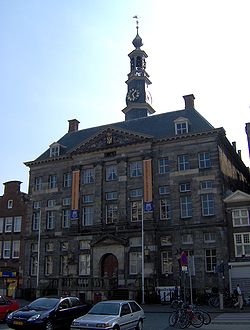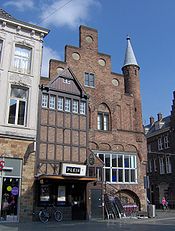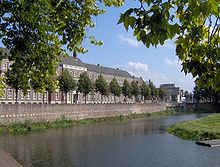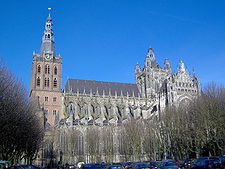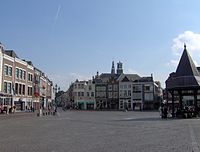- 's-Hertogenbosch
-
's-Hertogenbosch — Municipality — City hall 
Flag
Coat of armsCoordinates: 51°42′N 5°19′E / 51.7°N 5.317°ECoordinates: 51°42′N 5°19′E / 51.7°N 5.317°E Country Netherlands Province North Brabant Area(2006) – Total 91.26 km2 (35.2 sq mi) – Land 84.63 km2 (32.7 sq mi) – Water 6.64 km2 (2.6 sq mi) Population (1 January 2008) – Total 136,499 – Density 1,602/km2 (4,149.2/sq mi) Source: CBS, Statline. Time zone CET (UTC+1) – Summer (DST) CEST (UTC+2) 's-Hertogenbosch (Dutch pronunciation: [ˌsɛrtoːɣə(n)ˈbɔs] (
 listen), literally "The Duke's Forest")—translated in French as Bois-le-Duc, in German as Herzogenbusch, in Spanish as Bolduque, in Italian as Boscoducale and in Latin Silva Ducis—is a municipality in the Netherlands, and also the capital of the province of North Brabant. It is located in the southern Netherlands, some 80 km south of Amsterdam (map).
listen), literally "The Duke's Forest")—translated in French as Bois-le-Duc, in German as Herzogenbusch, in Spanish as Bolduque, in Italian as Boscoducale and in Latin Silva Ducis—is a municipality in the Netherlands, and also the capital of the province of North Brabant. It is located in the southern Netherlands, some 80 km south of Amsterdam (map).The Dutch colloquially seldom say 's-Hertogenbosch but rather Den Bosch [dɛmˈbɔs] (
 listen), which is traditional Dutch for "The Forest".
listen), which is traditional Dutch for "The Forest".Contents
Population centres
Bokhoven, Crevecoeur, Deuteren (former village), Dieskant, Empel, Engelen, Gewande, 's-Hertogenbosch, Hintham, Kruisstraat, Maliskamp, Meerwijk, Orthen (former village), Oud-Empel and Rosmalen.
History
The city's official name is a contraction of the Dutch des Hertogen bosch—"the Duke's forest". The duke in question was Henry I, Duke of Brabant, whose family had owned a large estate at nearby Orthen for at least four centuries. He founded a new town located on some forested dunes in the middle of a marsh. At age 26, he granted 's-Hertogenbosch city rights and the corresponding trade privileges in 1185. This is, however, the traditional date given by later chroniclers; the first mention in contemporaneous sources is 1196. The original charter has been lost. His reason for founding the city was to protect his own interests against encroachment from Gelre and Holland; from its first days, he conceived of the city as fortress. It was destroyed in 1203 in a joint expedition of Gelre and Holland, but was soon rebuilt. Some remnants of the original city walls may still be seen. In the late 15th century, a much larger wall was erected to protect the greatly expanded settled area. Artificial waterways were dug to serve as a city moat, through which the rivers Dommel and Aa were diverted.
Until 1520, the city flourished, becoming the second largest population centre in the territory of the present Netherlands, after Utrecht. The birthplace and home of one of the greatest painters of the northern Renaissance, Hieronymus Bosch, the city was also a center of music, and composers, such as Jheronimus Clibano, received their training at its cathedrals. Others held positions there: Matthaeus Pipelare was musical director at the Confraternity of Our Lady; and renowned Habsburg copyist and composer Pierre Alamire did much of his work at 's-Hertogenbosch.
Eighty Years' War
The wars of the Reformation changed the course of the city's history. It became an independent bishopric. During the Eighty Years' War, the city took the side of the Habsburg (Catholic) authorities and thwarted a Calvinist coup. It was besieged several times by Prince Maurice of Orange, stadtholder of Holland, who wanted to bring 's-Hertogenbosch under the rule of the rebel United Provinces. The city was successfully defended by Claude de Berlaymont, also known as Haultpenne.
Thirty Years' War
In the years of Truce, before the renewed fighting after 1618, the fortifications were greatly expanded. The surrounding marshes made a siege of the conventional type impossible, and the fortress, deemed impregnable, was nicknamed the Marsh Dragon. The town was nevertheless finally conquered by Frederik Hendrik of Orange in 1629 in a typically Dutch stratagem: he diverted the rivers Dommel and Aa, created a polder by constructing a forty-kilometre dyke and then pumped out the water by mills. After a siege of three months, the city had to surrender—an enormous blow to Habsburg geo-political strategy during the Thirty Years' War. This surrender cut the town off from the rest of the duchy and the area was treated by the Republic as an occupation zone without political liberties (see also Generality Lands).
Louis XIV to Bonaparte
After the Peace of Westphalia, the fortifications were again expanded. In 1672, the Dutch rampjaar, the city held against the army of Louis XIV. In 1794, French revolutionary troops under command of Charles Pichegru took the city with hardly a fight: in the Batavian Republic, both Catholics and Brabanders at last gained equal rights.
From 1806, the city became part of France. It was captured by the Prussians in 1814. The next year, when the United Kingdom of the Netherlands was established, it became the capital of North Brabant. Many newer and more modern fortresses were created in the vicinity of the city. Until 1878 it was forbidden to build outside the ramparts. This led to overcrowding and the highest infant mortality in the kingdom. The very conservative city government prevented industrial investment—they didn't want the number of workers to grow—and the establishment of educational institutions—students were regarded as disorderly. As a result, the relative importance of the city diminished.
World War II and after
One of the few official Nazi concentration camp complexes in western Europe located outside of Germany and Austria was named after 's-Hertogenbosch. It operated from January, 1943, to September, 1944 and was known to the Germans as Herzogenbusch (see List of subcamps of Herzogenbusch). About 30,000 inmates were interned in the complex during this time, of whom about 12,000 were Jews. In the Netherlands, this camp is known as 'Kamp Vught', because the concentration camp was actually located at a heath near Vught, a village a few kilometres south of 's-Hertogenbosch. In a tragic coincidence, the entire Jewish population of 's-Hertogenbosch was burnt alive on the same heath in the 13th century.
Conquered by the Germans in World War II (1940), it was liberated in 24–27 October 1944 by the British 53rd (Welsh) Division.This town was mentioned on 'Who do Think You Are?' TV programme where Rory Bremner's father, a member of 1st Battalion, the East Lancashire Regiment were the first to liberate the town. This testimony was given by a resident of the town and he wore the tie of the East Lancs to commemorate the event.
Main sights
's-Hertogenbosch was founded as a fortified city and that heritage can still be seen today. After World War II, plans were made to modernise the old city, by filling in the canals, removing or modifying some ramparts and reconstructing historic neighbourhoods. Before these plans could come to effect however, the central government declared the city a protected townscape. Most historic elements have been preserved. Because the main ramparts are crucial in keeping out the water, they have never been slighted, their usual fate in the Netherlands. In contrast to cities like Rotterdam, 's-Hertogenbosch also survived the Second World War relatively unscathed. Much of its historic heritage remains intact, and today there are always renovations going on in the city to preserve the many old buildings, fortifications, churches and statues for later generations. In 2004 the city was awarded the title European Fortress City of the year. It is planned to restore the city defences to much of their old glory in the coming years. 's-Hertogenbosch also has the oldest remaining brick house in the Netherlands, 'de Moriaan', which was built at the beginning of the 13th century. In the north of the old city, the hexagonal powder arsenal, or Kruithuis, still exists, one of only two of its kind in the country. The Townhall is a 17th century building, erected in the typical style of Dutch classicism. Around the city itself many other fortresses can still be seen. Until recently it was a major garrison town.
The old city of 's-Hertogenbosch is still almost completely surrounded by continuous ramparts. On the south side, this wall still borders on an old polder, kept intact as a nature reserve, that stretches all the way to Vught. These city walls are currently undergoing renovations. Hidden below the old city is a canal network called the Binnendieze that once spanned 22 kilometres. It started out as a regular river, the Dommel, running through the city in medieval times but due to lack of space in the city, people started building their houses and roads over the river. In later times it functioned as a sewer and fell into disrepair. In recent decades, the remaining sixth of the old waterway system has been renovated, and it is possible to take several guided subterranean boat trips through it.
's-Hertogenbosch is also home to Saint John's Cathedral (Sint Jans kathedraal in Dutch) which is said to be one of the most beautiful cathedrals in the Netherlands. The Cathedral dates from circa 1220 and is best known for its (Brabantian) gothic design and the many sculptures of craftsmen that are sitting on almost every arc and rim along the outside of the cathedral. At the time of writing, the cathedral is being extensively renovated to undo the damage of many years of wear-and-tear and acid rain.
The painter Hieronymus Bosch (c. 1450–1516) remains probably the best known citizen of 's-Hertogenbosch.
The city is also home to the Bolwoningen, 50 experimental spherical houses designed by Dries Kreijkamp.[1]
51°43′48″N 5°18′25″E / 51.729918°N 5.306938°E
Economy
The city of 's-Hertogenbosch has become a centre of industry, education, administration and culture. It is currently the fourth city of Noord Brabant. It is home to many national and international businesses such as Heineken, Tyco International and many others.
Culture
's-Hertogenbosch is home to a variety of events such as the theatre festival Boulevard, Jazz in Duketown,and hip hop in duketown the start of the Tour de France (1996), Tour Feminine (1997), the International Vocal Competition, November Music (a contemporary music festival) and the Unicef Open (formerly the Ordina Open) grass court tennis tournament (in the nearby town of Rosmalen). There are also over 350 restaurants, pubs and cafés to be found in the city.
Den Bosch is also home to the European Ceramic Work Centre, currently branded as Sundaymorning@ekwc. This is a juried international ceramic residency where they invite Artist, Designers and Architects from around to the world to explore the medium of Ceramics. This program was initially started in 1991 and continues to this day.
The city has its own food speciality, the Bossche Bol—effectively a giant profiterole, somewhat larger than a tennis ball, which is filled with whipped cream and coated with chocolate.
Sport
The city has one professional football club, FC Den Bosch (first club of Dutch international player Ruud van Nistelrooy), and is also the home to top field hockey club HC Den Bosch, basketball team EiffelTowers Den Bosch and 2008 national rugby champion The Dukes
Once a year 's-Hertogenbosch changes its name to "Oeteldonk". Contrary to popular belief, "oetel" in the name "Oeteldonk" is not a referral to a frog but is a facetious reference to the 's-Hertogenbosch Bishop Adrianus Godschalk who came from the village of Den Dungen, and he often fulminated against the 'pagan' Carnaval festivities. Van den Oetelaar was a very common name in Den Dungen at that time. "Donk" is a reference to a dry place in the marsh. The frog is however a symbol often used during Carnaval, and it is a symbol of the Oeteldonk Marsh.[2]
This change only lasts for the three days of Carnaval, a Catholic holiday for celebrating the days before Lent. The Mayor then hands over his duties temporarily to "Peer vaan den Muggenheuvel tot den Bobberd" during this three-day festival. "Peer vaan den Muggenheuvel tot den Bobberd" is the host of Prince Carnaval "Prince Amadeiro XXV" when he visits Oeteldonk.
Transport
's-Hertogenbosch has three railway stations:
- 's-Hertogenbosch
- 's-Hertogenbosch Oost
- Rosmalen
Notable people
- Patrick van Aanholt (1990), footballer (Chelsea F.C.)
- Hieronymus Bosch (c. 1450–1516), painter
- Mijntje Donners (1974), field hockey player, World Hockey player of the year 2003
- Fred van der Hoorn (1963), footballer (FC Den Bosch, Dundee United, Eendracht Aalst)
- Patrick Jumpen (1988), Jumpstyle artist
- Wim Kersten (1924–2001), composer and lyricist
- Marco Kroon (1970), recent recipient of the Militaire Willemsorde
- Anthony Lurling (1977), footballer (FC Den Bosch, Feyenoord, Heerenveen, NAC)
- Jan Pijnenburg (1955), musician, drummer of famous Dutch '80s band Doe Maar
- Maikel Scheffers (1982), wheelchair tennis player
- Arnold Scholten (1962), footballer (FC Den Bosch, Ajax, Feyenoord, JEF United)
- Andy Souwer (1982), kickboxer, two time K-1 World MAX Champion, reigning three time Shootboxing World Tournament Champion, born 1982
- Frans de Waal (1948), psychologist, primatologist and book author
- Leon de Winter (1954), writer and columnist
- Marianne Vos (1987), National, Olympic and World professional cycling champion
- Max Schellekens (1997), BASKETBALL CAPTAIN G-TEAM
References and notes
External links
- Municipality of 's-Hertogenbosch
- Herzogenbusch concentration camp
- Sounds of the city (click on red balloons) source: www.freesound.org
- www.globefield.nl
Aalburg · Alphen-Chaam · Asten · Baarle-Nassau · Bergeijk · Bergen op Zoom · Bernheze · Best · Bladel · Boekel · Boxmeer · Boxtel · Breda · Cranendonck · Cuijk · Deurne · Dongen · Drimmelen · Eersel · Eindhoven · Etten-Leur · Geertruidenberg · Geldrop-Mierlo · Gemert-Bakel · Gilze en Rijen · Goirle · Grave · Haaren · Halderberge · Heeze-Leende · Helmond · 's-Hertogenbosch · Heusden · Hilvarenbeek · Laarbeek · Landerd · Loon op Zand · Maasdonk · Mill en Sint Hubert · Moerdijk · Nuenen, Gerwen en Nederwetten · Oirschot · Oisterwijk · Oosterhout · Oss · Reusel-De Mierden · Roosendaal · Rucphen · Schijndel · Sint Anthonis · Sint-Michielsgestel · Sint-Oedenrode · Someren · Son en Breugel · Steenbergen · Tilburg · Uden · Valkenswaard · Veghel · Veldhoven · Vught · Waalre · Waalwijk · Werkendam · Woensdrecht · Woudrichem · Zundert

Capital cities of the Netherlands Categories:- 's-Hertogenbosch
- Cities in the Netherlands
- Populated places in North Brabant
- Provincial capitals of the Netherlands
- 1185 establishments
Wikimedia Foundation. 2010.

